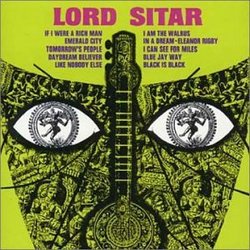Who Is Lord Sitar?
Laurence Upton | Wilts, UK | 01/21/2005
(3 out of 5 stars)
"The Lord Sitar project was conceived, produced, directed and arranged by John Hawkins for Zonophone/EMI in 1968 and infused western pop music with the eastern flavour of the sitar. It is really a pop album but has come to classed as psych/freakbeat by a new generation of musical explorers, and that suits the music fine, especially on the songs that fall most naturally into that category, such as the splendid I Can See For Miles, once heard never forgotten.
Some of the album is filler composed by John Hawkins or from obscure sources, and Emerald City is puzzling as the tune sounds like Beethoven's Ode To Joy and therefore recalls A Clockwork Orange rather than The Wizard Of Oz. Apparently this was a hit for the Seekers. Other pieces, though, such as If I Were A Rich Man and Daydream Believer (which may have been the single at the time) work wonderfully well.
The previous year Big Jim Sullivan had made a more serious album called Sitar Beat that had delved more deeply into the jazz possibilities of such a fusion on some tracks and had included John McLaughlin on guitar; and the same year John Mayer and Joe Harriott had released their landmark Indo Jazz Fusions sessions. The sitar became a fashionable instrument for the hipper groups to use to add coloration to their records, and so as the novelty eventually wore off the sitar largely disappeared from popular culture until Kula Shaker came along.
Jim Sullivan was one of the few to study the instrument in depth and could play with the genuine tonality the instrument demanded for the music to stay in tune. Another was George Harrison, whose composition Blue Jay Way is included here. John Hawkins' sleeve notes end with the question, "Who is Lord Sitar?", and previously hint that he may in fact be George Harrison, but it actually was Jim Sullivan, anonymous as he was contracted to Polydor at the time. Supporting musicians included Chriss Karen (tabla) and Ronnie Verel. When asked about the theory that the sitar was George Harrison playing, Sullivan enigmatically replied, probably tongue in cheek, "Perhaps it was on some tracks?""


 Track Listings (11) - Disc #1
Track Listings (11) - Disc #1